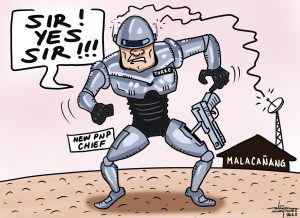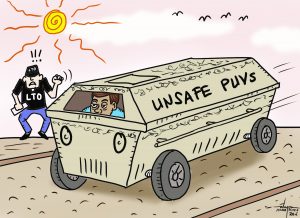We believe that there is urgent need for people of the City Engineer’s Office (CEO) to conduct inspections of roads in city barangays affected by the floods during the second half of 2019.
We have passed by some of these places especially those barangays in the third district. Since most barangay roads are now concreted the strong water current somehow failed to scour the concrete pavement. But what the water has destroyed are the road sides. The strong force of the current had washed out the soil and gravel fills on both sides of the concreted roads. This has resulted to the appearance of some kind of meter deep natural canals right after the floods.
The reason for this phenomenal creation is that most concreted roads in the barangays do not have drainage on the sides. Or, if there are, these are too small and shallow, and are not maintained. Therefore, whatever spaces intended for water passage are now blocked with massive growth of weeds. Some of the canals are also being converted by residents as their garbage dump sites.
Worst, there are barangays where the top of drainage canals are tolerated by officials of certain barangays to become “subdivisions” for informal settlers. Meaning, houses are being constructed on top of the canals where some of the posts are erected on the waterways.
If the CEO personnel assigned to conduct monitoring in the barangays are not lazy enough to do their jobs religiously, then we can be certain it is not difficult for them to locate the areas we are referring to.
All they need to do is go to Barangay Biao Guianga in the city’s third district. Upon reaching Kilometer 22 in Los Amigos they can turn right. There, starting from the junction of Davao-Bukidnon Road towards Biao Guianga they cannot fail to see train-like residential structures almost half a kilometer long now — and still extending.
These are houses with existing occupants. The structures’ frontage actually eats up the road easement leaving hardly a foot of space from the edge of the concrete pavement.
What surprise many passers-by in that stretch of the Guianga road from the highway is that the construction of the houses, though clearly illegal, is seemingly with approval by the officials of the barangay.
Are there no one among the barangay officials of Los Amigos who is aware of existing laws and ordinances banning construction of structures on drainage canals and natural waterways?
We do not know if it would be asking too much from the city mayor to squeeze a schedule for her to visit that particular site in Los Amigos so she would know if it is worth her ordering the CEO people to do what is necessary.
It is really ironic that in an area where Davao City has its largest relocation site there are informal settlers that need to be relocated. But no, they are allowed to build their houses where these could abet flash floods in that part of the city.
And perhaps the city office of the Department of Interior and Local Governments ((DILG) can look into its own mandate of imposing the responsibility on barangay officials seeing to it that they have to ensure that local and national laws are implemented at their level.
Yes, the barangay executives must be made accountable for whatever illegal activities done by village residents such as allocating roadside canals and easements for residential purposes.
And since these houses are installed electricity and water connections it is easy to presume these are issued building and electrical permits. Therefore, the CEO could be aware of the infractions.
**************************
The local government of Davao City has created a body to regulate heights of new buildings.
This could either be good or bad news. Good for those who think that there are still sizeable areas for horizontal development purposes; and bad for those who believe that land in the city has gone too costly. Yes, the land value in the city’s main business district had shot up to a new height these days that developers believe they have nowhere to go but pursue the vacant skyline.
Those who see plenty of spaces available in the city’s peripheries may also be right. But their strides are, at the same time, slowly driving the cost of land in the suburban areas like crazy. This lateral movement of development, for certain, is the coming true of a dream that semi and rural residents have long been dreaming of. But what they may not be aware of is, that this dream come true can be as unsettling as the one that does not. Look what’s happening now – floods, landslides, environmental degradation.
So, the creation of the new regulatory body for building heights by the city is a move in the right direction. We cannot wait for air accidents to happen right in the heart of Davao City’s main population and economic activity center to realize that the need for regulating building heights in certain downtown areas is now a “must do” thing.
But please do not make this a scheme with which to delay action on vertical development applications. This would run counter to the President and former Davao City mayor’s mandate to facilitate government transactions the fastest possible.


